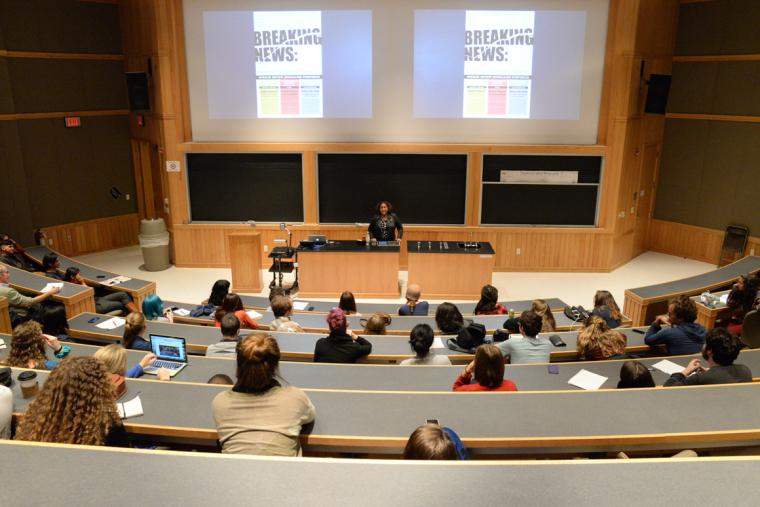Oberlin to Launch Integrative Concentration in Journalism
December 18, 2019
Communications Staff

Photo credit: Jeong Hyun Hwang
Rare approach builds upon the college’s long history of preparing some of the world’s leading journalists.
Oberlin will apply its core liberal arts curriculum to an integrative concentration in journalism designed to enhance its long history of preparing journalists for successful careers at some of the world’s leading media outlets.
When it is launched in fall 2020, Oberlin’s integrative concentration in journalism will differ from the programs found at traditional journalism schools. The concentration’s design will allow students to combine it with any of Oberlin’s more than 50 majors—whether in the humanities, social sciences, natural sciences, arts, or music—and merge coursework with cocurricular and extracurricular work, including internships and other forms of applied learning.
“Oberlin’s educational goals read like a checklist for journalists—critical thinking, communication skills, creativity. Our ethos also helps, as Obies like to engage with the world and to question authority,” says Sebastiaan Faber, international journalist, professor and chair of Hispanic Studies, and one of the new concentration’s primary architects.
“The creation of a journalism concentration simply establishes signposts to signal the path that many students have been finding on their own for generations, while helping to ensure that we offer consistently—and with purpose—relevant courses, invited speakers, internships, and the like.”
“I am pleased we moved so quickly towards the academic integration that the One Oberlin report recommended,” says President Carmen Twillie Ambar. “The integrative concentration in journalism is an important part of this comprehensive effort.”
Oberlin has long produced outstanding journalists, defined broadly as individuals who communicate in a variety of nonfiction genres about current matters, including newspaper, magazine, and online reporting; writing and editing creative nonfiction and nonfiction books; radio production and podcasting; and documentary filmmaking.
Journalism has undergone rapid and disruptive change in recent years, creating a need for an innovative approach to prepare students for a career that remains extremely popular. 44 percent of current students expressed high interest in the idea of a journalism program at Oberlin, when surveyed last year.
“I see the new journalism concentration as an exciting opportunity to formally recognize the high level of interest that many Oberlin students have in learning the skills of the trade,” says Nathan Carpenter, a current senior and editor in chief of the Oberlin Review.
“Student journalists are on the front lines of a quickly changing field. My hope for this concentration is that it will help Obies gain the skills and experiences necessary to continue shaping journalism well into the future, as many Oberlin alumni have already done,” Carpenter says.
The new concentration will serve the career goals of students interested in a variety of forms of journalism, such as news and political reporting; investigative, music, and science journalism; literary criticism; and related communications careers.
The concentration’s developers also hope the new approach will attract more people from underrepresented minority communities who choose to enter the journalism field.
“It’s clear that the future of journalism will depend on expanding the points of view in newsrooms and editor offices–including the voices of more people of color, people with disabilities, and LGBTIAQ folks,” says Jan Cooper, associate professor of rhetoric and composition and English and another architect of the new program. “I’m especially hoping that our integrative concentration in journalism will help make that happen.”
“We need smart, thoughtful, and well-trained journalists more than ever in our country,” says Jim Axelrod, chief investigative and senior national correspondent for CBS News. “As a parent of an Obie, I know firsthand how an Oberlin education helps develop both sharp minds and compassionate hearts. The new integrative concentration in journalism at Oberlin will train some terrific students for a profession that badly needs them, and the sensibilities they’ve refined on the Oberlin campus.”
The Department of Rhetoric and Composition will oversee the integrative concentration, which was designed by Professors Faber and Cooper, along with Laurie McMillin, professor of rhetoric and composition.
“At a moment when the very notion of objective facts seems in doubt—a skepticism that threatens democracy—there could be no better time for Oberlin to create a concentration in journalism,” says Tom Rosenstiel ’78, director of the American Press Institute.
”While the fundamental principles endure, we need new methodologies about how to practice this profession, which is so vital to self governing,’’ Rosenstiel says. ‘‘The world needs a new, better journalism that draws on the lessons of neuroscience, ethnography, anthropology, computer science, statistics, and new forms of visual story telling; all disciplines at which Oberlin excels. Oberlin’s distinctly rich way of teaching will help invent a new and better way of educating the next generation of journalists.”
Read about the Integrative Concentration in Journalism program
You may also like…
Josh Nolan Named Vice President, General Counsel, and Secretary at Oberlin
Distinguished attorney brings extensive experience in higher education law.
Learning by Teaching: Oberlin Students Share Global Music with Young Learners
College and Conservatory students in PACE 103 prepare local children for an immersive community concert at Oberlin.
Nuiko Wadden ’02 Joins Oberlin Conservatory Faculty as Assistant Professor of Harp
The versatile musician brings extensive opera, orchestral, and contemporary music experience to her role


